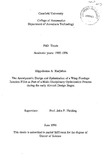JavaScript is disabled for your browser. Some features of this site may not work without it.
| dc.contributor.advisor | Fielding, John | |
| dc.contributor.author | Hadjiilias, Hippokrates A. | |
| dc.date.accessioned | 2009-06-10T15:32:15Z | |
| dc.date.available | 2009-06-10T15:32:15Z | |
| dc.date.issued | 1996-06 | |
| dc.identifier.uri | http://hdl.handle.net/1826/3443 | |
| dc.description.abstract | An attempt to minimize interference drag in a wing-fuselage junction by means of inserting a fillet is presented in this thesis. The case of a low-wing com- mercial transport aicraft at cruise conditions is examined. Due to the highly three dimensional behaviour of the flow field around the junction, a thin-layer Navier-Stokes code was implemented to estimate the drag forces at the junc- tion. Carefully selected design variable combinations based on-the theory of Design of Experiments constituted the initial group of feasible cases for which the flow solver had to be run. The drag values of these feasible cases were then used to create a second order response surface which could predict with rea- sonable accuracy the interference drag given the value of the design variables within the feasible region. A further optimization isolated the minimum in- terference drag combination of design variable values within the design space. The minimurn interference drag combination of design variable values was eval- uated numerically by the flow solver. The prediction of the response surface and the numerical value obtained by the flow solver for the interference drag of the optimal wing-fuselage combination differed by less than five percent. To demonstrate the ability of the method to be used in an interdisciplinary analysis and optimization program, a landing gear design module is included which provides volume constraints on the fillet geometry during the fillet sur- face definition phase. The Navier Stokes flow analyses were performed on the Cranfield Cray su- percomputer. Each analysis required between eight to twelve CPU hours, and the total CPU time required for the optimization of the six variable model described in the thesis required thirty Navier Stokes runs implementing the Design of Experimens and Surface Response Methodology implementation. For comparison, a typical optimization implementing a classical conjugate di- rections optimizer with no derivative information available would probably require more than forty iterations. Both the optimization and the flow solver results are discussed and some recommendations for improving the efficiency of the code and for further ap- plications of the method are given. | en_UK |
| dc.language.iso | en | en_UK |
| dc.publisher | Cranfield University | en_UK |
| dc.title | The aerodynamic design and optimization of a wing-fuselage junction fillet as part of a multi-disciplinary optimization process during the early aircraft design stages | en_UK |
| dc.type | Thesis or dissertation | en_UK |
| dc.type.qualificationlevel | Doctoral | en_UK |
| dc.type.qualificationname | PhD | en_UK |
